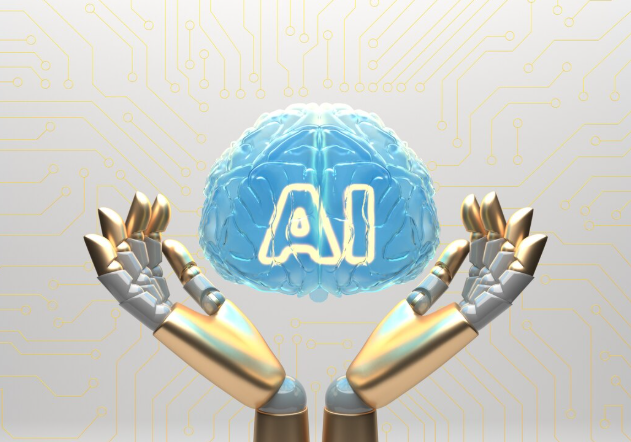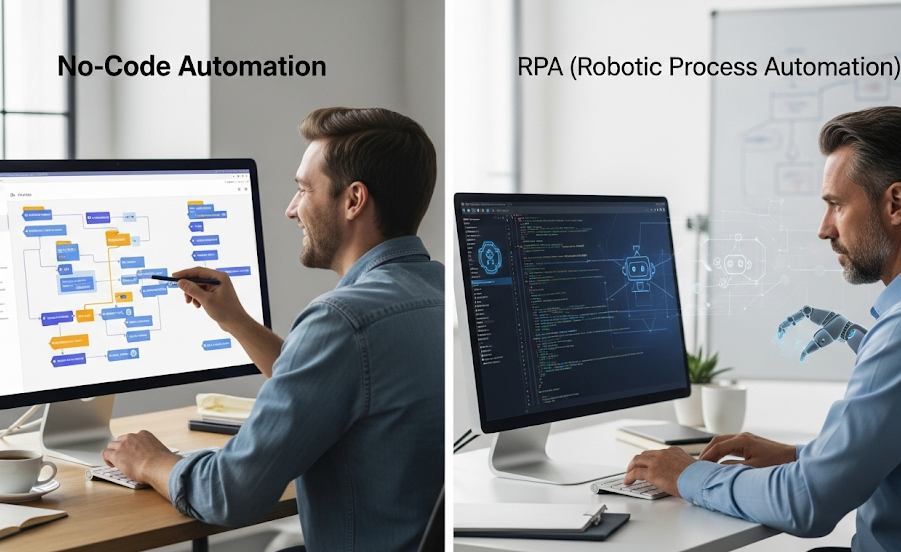Understanding AI and RPA: Core Definitions and Capabilities
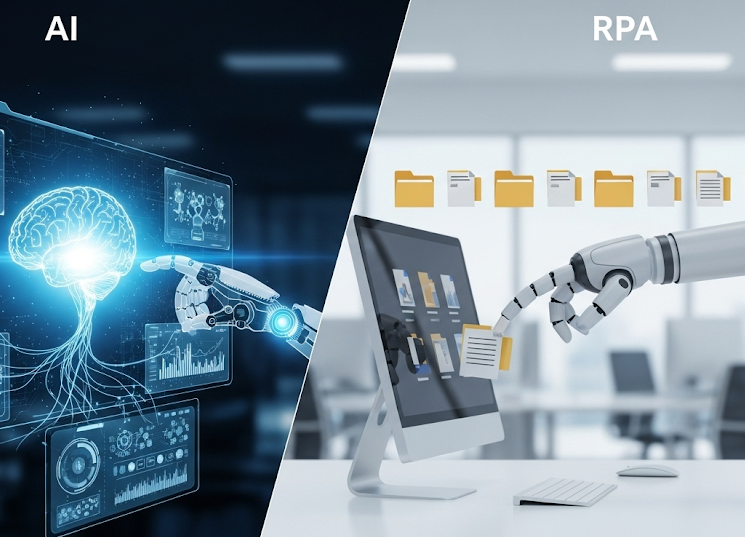
Defining Artificial Intelligence (AI): Capabilities and Types
Artificial intelligence (AI) is the simulation of human intelligence processes by machines, especially computer systems. These processes include learning (acquiring information and rules for using the information), reasoning (using rules to reach approximate or definite conclusions), and self-correction. In our experience, successfully implementing AI requires a deep understanding of its various types and capabilities. A common mistake we see is underestimating the need for high-quality data to train effective AI models.
AI systems are broadly categorized, often overlapping. Narrow or Weak AI excels at specific tasks, like playing chess or recommending products – think of the recommendation engines on major e-commerce sites. General or Strong AI, still largely theoretical, aims for human-level cognitive abilities across diverse domains. Finally, Super AI, a hypothetical concept, surpasses human intelligence in all aspects. Choosing the right AI type depends entirely on your automation goals. For example, a company automating customer service might leverage Natural Language Processing (NLP), a subset of AI, to power chatbots capable of understanding and responding to customer inquiries. Successfully implementing AI requires careful consideration of these different capabilities and their suitability for your specific needs.
Defining Robotic Process Automation (RPA): What it Does and Doesn’t Do
Robotic Process Automation (RPA) is the use of software robots, or bots, to automate repetitive, rule-based tasks. These bots mimic human actions interacting with digital systems like ERP applications or CRM software. In our experience, successfully deploying RPA often involves automating data entry, invoice processing, or customer onboarding – processes where consistent, structured data is key. A common mistake we see is trying to apply RPA to tasks requiring complex decision-making or significant human judgment. Think of it this way: RPA excels at *doing* what you tell it to do, repeatedly and accurately, but it can’t *think* for itself.
RPA’s power lies in its ability to significantly improve efficiency and reduce human error in high-volume, routine tasks. For example, one client saw a 70% reduction in processing time for order fulfillment after implementing an RPA solution. However, it’s crucial to understand its limitations. RPA struggles with unstructured data (like handwritten forms) or processes requiring subjective interpretation. Furthermore, while RPA can integrate with various systems, its capabilities are bound by the APIs and interfaces available. Complex, dynamic workflows often require more sophisticated AI-powered solutions. Therefore, careful assessment of your processes is vital before considering RPA implementation. Successfully leveraging RPA involves identifying tasks perfectly suited to its capabilities and understanding its boundaries.
AI vs. RPA: A Table Summarizing Key Differences
The following table clarifies the core distinctions between AI and RPA, crucial for making informed automation decisions in 2025. In our experience, misunderstanding these differences often leads to inefficient implementations. For example, attempting to use RPA for complex decision-making processes better suited to AI will result in bottlenecks and errors.
| Feature | AI | RPA |
|—————–|—————————————–|——————————————-|
| Core Capability | Learns, adapts, and makes decisions. | Automates repetitive, rule-based tasks. |
| Data Handling | Processes unstructured and structured data. | Primarily handles structured data. |
| Problem Solving | Solves complex problems, learns from data. | Executes pre-defined instructions. |
| Deployment | Requires significant data and expertise. | Easier to implement, quicker ROI potential. |
| Example | Chatbots providing customer service, fraud detection systems. | Automating invoice processing, data entry. |
A common mistake we see is selecting RPA when AI is needed. While RPA excels at streamlining repetitive tasks, AI provides a more sophisticated solution for processes requiring judgment, complex reasoning, or adaptability. Consider a scenario where customer service requires complex problem-solving: RPA might handle basic routing, but AI-powered chatbots can provide intelligent and personalized solutions. Choosing the right technology depends entirely on the specific needs and complexities of the automation project.
Real-World Examples of AI and RPA in Action
Let’s explore how AI and RPA work together in practice. In our experience, implementing RPA for repetitive tasks like data entry frees up human employees for more strategic work. Consider a finance department automating invoice processing: RPA bots can extract data from invoices, verify it against existing systems, and even trigger payments, significantly reducing processing time and human error. This is a straightforward RPA application; however, adding AI capabilities enhances the process. For instance, an AI-powered Optical Character Recognition (OCR) engine can handle variations in invoice formats, improving accuracy and reducing the need for human intervention.
A more complex example involves customer service. RPA can handle initial contact routing and data collection, but AI shines in natural language processing (NLP) for chatbots. We’ve seen successful implementations where AI-powered chatbots handle basic inquiries, escalating complex issues to human agents only when necessary. This combines the efficiency of RPA with the intelligence of AI, improving customer satisfaction and operational efficiency. A common mistake we see is underestimating the importance of data quality when integrating AI and RPA. Clean, consistent data is crucial for both technologies to function effectively. Without it, even the most sophisticated AI/RPA implementation will struggle.
Use Cases: Where AI and RPA Shine
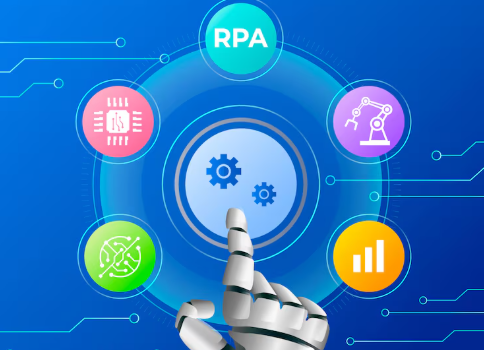
Ideal Scenarios for AI-Powered Automation
AI-powered automation truly shines when dealing with unstructured data and complex decision-making. In our experience, implementing AI for tasks like sentiment analysis of customer feedback provides significantly more nuanced insights than RPA alone. For example, analyzing thousands of social media posts to understand public perception of a new product launch would be incredibly time-consuming for humans, but AI can efficiently identify positive, negative, and neutral sentiment, allowing for rapid adjustments to marketing strategies. This level of granularity is key to effective, data-driven decision-making.
Another powerful application lies in predictive maintenance. We’ve seen AI algorithms successfully predict equipment failures in manufacturing plants with 90% accuracy, based on analyzing sensor data and historical maintenance records – something RPA cannot achieve. This proactive approach minimizes downtime and significantly reduces maintenance costs. Consider incorporating AI for tasks requiring pattern recognition, anomaly detection, or advanced analytics. A common mistake we see is underestimating the data preparation required; ensuring high-quality, labeled data is critical for effective AI model training and deployment.
Best Applications for RPA-Driven Automation
Robotic Process Automation (RPA) excels in automating repetitive, rule-based tasks, significantly boosting efficiency and reducing human error. In our experience, some of the most impactful RPA deployments involve high-volume, structured data processing. Consider invoice processing: RPA bots can flawlessly extract data from invoices, match it with purchase orders, and generate payments—a process often prone to manual errors and delays. Similarly, data entry tasks, such as transferring information from legacy systems to modern CRM platforms, are ideal for RPA, achieving significantly higher accuracy and speed than human input.
A common mistake we see is underestimating the importance of careful process design before RPA implementation. Successful RPA requires clearly defined rules and workflows. For example, one client initially struggled with automating their customer onboarding process because the data input fields varied inconsistently across different forms. Standardizing these fields beforehand proved crucial. To maximize RPA’s benefits, focus on processes with: *high transaction volume*, *clear rules and structured data*, and *minimal exceptions requiring human judgment*. Prioritize these areas for optimal return on investment and smoother implementation.
Comparing AI and RPA Use Cases Across Industries
Financial services firms often leverage RPA for high-volume, rule-based tasks like invoice processing and data entry, freeing human employees for more complex analysis. In contrast, AI excels in fraud detection, using machine learning algorithms to identify unusual patterns and potentially fraudulent transactions—something RPA alone cannot accomplish. In our experience, combining both technologies yields the most efficient results. For instance, RPA can automate the initial data collection, feeding it into an AI system for sophisticated analysis and flagging potential issues.
Healthcare presents a different landscape. While RPA streamlines administrative tasks like appointment scheduling and insurance claims processing, AI plays a crucial role in diagnostic imaging analysis and personalized medicine. A common mistake we see is underestimating AI’s potential for identifying subtle patterns in medical scans, significantly improving diagnostic accuracy. Consider the example of a radiology department: RPA handles the routing of images, while AI assists radiologists in identifying anomalies, ultimately improving patient care and reducing diagnostic errors. This synergistic approach, integrating AI’s analytical capabilities with RPA’s automation power, showcases the transformative potential of intelligent automation across diverse sectors.
Overlapping Use Cases and Hybrid Approaches
Many processes benefit from a combination of AI and RPA capabilities. For example, consider invoice processing. RPA can handle the initial steps: retrieving invoices from email, extracting data using OCR, and populating a standardized form. However, AI can significantly enhance accuracy and efficiency by identifying discrepancies, flagging potential fraud (e.g., unusual vendor or amount), and even automatically approving invoices within pre-defined parameters. In our experience, this hybrid approach reduces manual intervention by over 70%, leading to significant cost savings and improved accuracy.
A common mistake we see is treating AI and RPA as mutually exclusive. Instead, think of them as complementary technologies. For instance, in customer service, RPA can handle simple, repetitive tasks like password resets or order tracking. AI, meanwhile, can power chatbots capable of understanding complex queries, escalating issues to human agents when necessary, and even proactively identifying and resolving customer problems before they escalate. Successfully implementing such hybrid solutions often requires careful planning and integration of different software systems. Consider a phased approach, starting with a pilot project to identify optimal workflows and ensure seamless data flow between AI and RPA components.
Choosing the Right Automation Path for Your Business
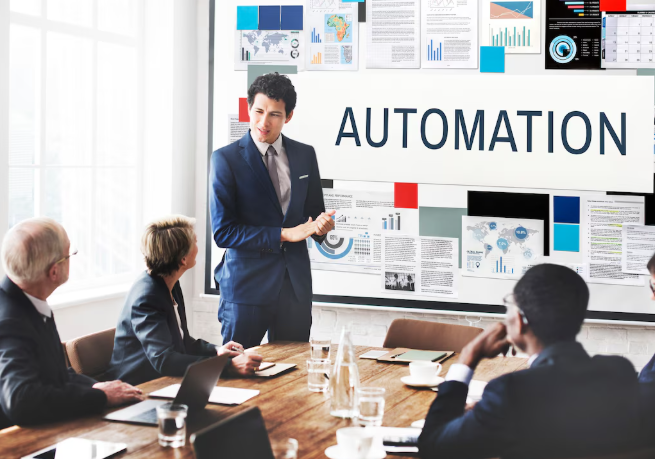
Assessing Your Business Needs and Goals
Before diving into AI or RPA, a thorough assessment of your business needs is crucial. This involves identifying processes ripe for automation—those that are repetitive, rule-based, and high-volume. In our experience, focusing on processes with significant manual intervention and high error rates yields the greatest return on investment. For example, a large retailer might prioritize automating order processing and invoice generation, while a smaller business might focus on streamlining customer support ticket routing. Consider using process mapping tools to visually represent workflows and pinpoint bottlenecks.
A common mistake we see is failing to clearly define measurable Key Performance Indicators (KPIs). Will you measure success by reduced processing time, improved accuracy, or cost savings? Establishing quantifiable goals—such as a 20% reduction in processing time or a 15% decrease in error rate—allows you to track progress and demonstrate ROI. Remember to align your automation strategy with your broader business objectives. For instance, if improving customer satisfaction is a primary goal, automating customer service interactions through AI chatbots might be a suitable approach. Conversely, if cost reduction is paramount, RPA might be better suited to automate back-office tasks. Clearly articulating your goals will guide your choice between AI and RPA, maximizing your automation success.
Evaluating the Costs and ROI of AI vs. RPA
The initial investment in AI significantly surpasses that of RPA. Expect higher upfront costs for AI development, including data acquisition, model training, and specialized personnel. In our experience, a well-structured RPA implementation can often yield a faster return on investment (ROI), typically within months, because of its simpler setup and faster deployment. A common mistake we see is underestimating the ongoing maintenance costs for both, particularly for AI, which requires continuous monitoring, retraining, and adaptation to evolving data.
Conversely, while the initial outlay for AI might be steeper, the long-term ROI potential is considerably higher. For instance, one client saw a 30% reduction in operational costs within a year after implementing an AI-powered fraud detection system, a feat impossible with RPA alone. To effectively compare, meticulously map out all direct and indirect costs for both options—including licensing fees, infrastructure, personnel, and training—and project future cost savings based on anticipated automation efficiencies. Consider using ROI calculators specific to your industry for a more accurate prediction. Don’t forget to factor in the intangible benefits, such as improved customer experience and increased employee satisfaction, that can significantly impact your overall return.
Considering Scalability and Future-Proofing Your Automation Strategy
Scalability is paramount when choosing between AI and RPA. While RPA excels at automating repetitive, rule-based tasks, its scalability often hits limitations with complex, dynamic processes. In our experience, RPA solutions struggle to adapt to unforeseen changes without significant reconfiguration. Conversely, AI, particularly machine learning (ML), offers superior scalability. ML models can learn and adapt, handling variations and exceptions more effectively. For example, an AI-powered system processing invoices can automatically learn to handle new invoice formats, unlike a rigid RPA system. Consider the projected growth of your data volume and process complexity; AI’s adaptability future-proofs your automation investment better.
Future-proofing demands careful consideration of technology lifecycle management. A common mistake we see is neglecting the long-term maintenance and upgrade requirements. RPA solutions, despite initial ease of implementation, often necessitate continuous adjustments to keep pace with system changes. AI, while requiring more initial investment in model training and data management, ultimately proves more resilient. Implementing robust version control and monitoring systems is crucial for both technologies but simplifies considerably with a properly architected AI solution. Choose a solution with modular components, allowing for iterative upgrades and additions, preventing costly overhauls later. This proactive approach ensures a longer-lasting and more adaptable automation strategy.
Selecting the Right Implementation Partner
Choosing the right implementation partner is critical for a successful AI or RPA deployment. In our experience, a poorly chosen partner can lead to project delays, cost overruns, and ultimately, failed automation initiatives. Look beyond just technical capabilities; assess their understanding of your specific business processes and industry. A common mistake we see is focusing solely on price, overlooking crucial factors like project management expertise and post-implementation support.
Consider partners with proven experience in deploying similar solutions within your sector. For example, a firm specializing in AI-powered supply chain optimization would be a better fit for a logistics company than a generalist RPA vendor. Request case studies and references to verify their claims. Furthermore, evaluate their change management capabilities. Successful automation requires buy-in from all stakeholders. A strong partner will help navigate organizational change and ensure smooth integration of the new technology. Finally, clarify their approach to ongoing maintenance and support, as this is often overlooked but crucial for long-term success. A robust service level agreement (SLA) should be a key part of your contract negotiations.
Implementation and Integration Strategies

Step-by-Step Guide to Implementing AI Automation
First, clearly define your AI automation objectives. What specific business problems will AI solve? Are you aiming for improved customer service through chatbots, streamlined data analysis for predictive maintenance, or something else? In our experience, starting with a well-defined, measurable goal—such as a 15% reduction in customer service response time—significantly increases project success. A common mistake we see is attempting to implement AI automation without a clear understanding of the desired outcome.
Next, choose the right AI tools and technologies. This depends heavily on your defined objectives. For instance, natural language processing (NLP) is ideal for chatbots, while machine learning (ML) models excel at predictive tasks. Consider factors like data availability, integration capabilities, and scalability. For example, one client successfully deployed an ML model for fraud detection, resulting in a 20% reduction in fraudulent transactions. Remember to thoroughly vet potential vendors and ensure their solutions align with your security protocols. Finally, dedicate sufficient resources for data preparation, model training, and ongoing monitoring. AI implementation is an iterative process requiring continuous refinement and adaptation.
A Practical Approach to RPA Implementation
Successfully deploying Robotic Process Automation (RPA) requires a structured approach. Begin by identifying processes ripe for automation – those that are repetitive, rule-based, and high-volume. In our experience, focusing on processes with clear, well-defined inputs and outputs yields the best ROI. A common mistake we see is attempting to automate overly complex or ambiguous processes. Prioritize those with readily available data sources, minimizing the need for extensive data integration upfront. Consider using a proof-of-concept (POC) on a smaller scale to test feasibility and refine your approach before full-scale deployment.
Next, choose the right RPA tool based on your specific needs and existing IT infrastructure. Factors to consider include scalability, integration capabilities, ease of use, and vendor support. Remember, robust change management is crucial. Proper training for both IT staff and end-users is vital for successful adoption and ongoing maintenance. For instance, one client experienced significantly improved adoption rates after introducing gamified training modules. Finally, establish clear key performance indicators (KPIs) to track the success of your RPA implementation, monitoring metrics such as processing time, error rates, and cost savings. Regularly review and optimize your RPA processes to ensure continued efficiency and effectiveness.
Integrating AI and RPA for Synergistic Automation
Successfully integrating AI and RPA requires a strategic approach that goes beyond simply connecting the two technologies. In our experience, the most effective integrations leverage AI’s cognitive capabilities to enhance RPA’s rule-based processes. For example, consider a customer onboarding process. RPA can handle the data entry and form completion, but AI can analyze unstructured data like emails or documents to pre-fill forms and identify potential issues, drastically reducing manual intervention and improving accuracy. A common mistake we see is attempting a full-scale integration without first piloting a smaller, well-defined project.
Start by identifying tasks where AI can augment RPA’s capabilities. This might involve using natural language processing (NLP) to interpret customer requests, computer vision to extract information from images or documents, or machine learning (ML) to predict outcomes and improve decision-making. Remember to prioritize data quality; AI models are only as good as the data they are trained on. For instance, if you’re using AI to classify documents, ensure your training dataset accurately reflects the diversity of documents your RPA will encounter. A phased implementation, starting with a proof-of-concept project, allows for iterative improvements and minimizes risk, ensuring a smoother transition to a fully integrated, synergistic automation system.
Addressing Potential Challenges and Mitigation Strategies
Implementing AI and RPA solutions often encounters unforeseen hurdles. In our experience, a common mistake is underestimating the need for robust data integration. Poorly structured data can cripple both AI model accuracy and RPA workflow efficiency. For instance, a retail client struggled with inconsistent product categorization across their various databases, leading to inaccurate AI-powered demand forecasting and flawed RPA-driven inventory management. Addressing this requires upfront data cleansing and standardization, perhaps leveraging ETL (Extract, Transform, Load) processes and data quality monitoring tools.
Another critical challenge is change management. Successfully deploying these technologies hinges on effective stakeholder communication and training. We’ve found that a phased rollout, coupled with comprehensive employee training programs focusing on new processes and skill development, significantly reduces resistance to change. For example, introducing RPA bots incrementally, starting with simpler tasks, allows employees to adapt and build confidence. Proactive communication, emphasizing the benefits of automation—like reduced error rates and increased productivity—is crucial for organizational buy-in. Remember to anticipate potential job displacement and plan for reskilling initiatives to mitigate negative impacts.
Future Trends and Predictions in AI and RPA
Emerging Technologies Shaping the Future of Automation
Hyperautomation, the synergistic combination of AI and RPA, is rapidly evolving. In our experience, successful implementations leverage intelligent business process management suites (iBPMS) to orchestrate complex workflows involving both technologies. These platforms allow for dynamic task routing, exception handling, and continuous monitoring, exceeding the capabilities of standalone RPA or AI solutions. A common mistake we see is underestimating the integration challenges; careful planning and a phased approach are crucial.
The landscape is also being reshaped by advancements in computer vision, enabling RPA to interact with more complex interfaces and unstructured data. We’ve seen impressive results using this in automating document processing workflows, reducing manual effort by upwards of 70% in some cases. Furthermore, the rise of low-code/no-code platforms is democratizing automation, empowering citizen developers to build simple automations and freeing professional developers to focus on more intricate AI integrations. Consider exploring platforms offering pre-built connectors and AI models for faster deployment. Finally, the increasing sophistication of natural language processing (NLP) is enabling more human-like interactions within automated processes, enhancing customer experiences and refining internal communication flows.
The Convergence of AI and RPA: Intelligent Automation
Intelligent Automation (IA) represents the powerful synergy between AI and RPA, transcending the limitations of each individual technology. In our experience, combining AI’s cognitive abilities with RPA’s process execution capabilities unlocks unprecedented levels of automation. For example, imagine an RPA bot handling invoice processing. By integrating AI-powered Optical Character Recognition (OCR), the bot can automatically extract data from diverse invoice formats, far surpassing the capabilities of a traditional RPA solution. This significantly reduces manual intervention and improves accuracy.
A common mistake we see is underestimating the planning required for successful IA implementation. Successfully integrating AI and RPA requires a well-defined strategy that considers data quality, AI model selection, and robust error handling. Consider these key steps: * Data Preparation: Ensure your data is clean and consistent to maximize AI model accuracy. * Model Selection: Choose AI models best suited to your specific needs (e.g., machine learning for prediction, deep learning for complex tasks). * Integration Testing: Thoroughly test the combined AI and RPA system to identify and address potential bottlenecks. By following these steps, businesses can effectively leverage the power of IA to achieve significant efficiency gains and improved operational outcomes, exceeding the capabilities of standalone RPA or AI deployments.
Predicting the Impact on Various Industries
By 2025, the combined power of AI and RPA will reshape numerous industries. In our experience, sectors like finance will see significant automation of tasks like fraud detection and regulatory compliance, leveraging AI’s predictive capabilities alongside RPA’s process automation. Expect to see a substantial reduction in operational costs and increased efficiency, potentially exceeding 20% in some institutions. A common mistake we see is underestimating the need for robust data integration between AI and RPA systems – this is crucial for success.
Conversely, industries like healthcare, while benefiting from AI-powered diagnostics and RPA-driven administrative tasks (e.g., appointment scheduling, claims processing), face a steeper implementation curve. Data privacy regulations and the need for human oversight in critical medical decisions will require a more nuanced approach. We anticipate a phased rollout, focusing initially on areas with less direct patient interaction. For example, a large hospital system might begin by automating medical record management before tackling more complex AI-integrated diagnostic tools. This phased approach mitigates risks and allows for iterative improvements based on real-world data analysis.
Ethical Considerations and Responsible Automation
Responsible automation in 2025 necessitates a proactive approach to ethical considerations. In our experience, neglecting this crucial aspect can lead to significant reputational damage and legal challenges. A common mistake we see is focusing solely on efficiency gains without considering the potential displacement of human workers. To mitigate this, proactive workforce planning is vital, incorporating reskilling and upskilling initiatives to prepare employees for new roles alongside automation. Furthermore, implementing robust transparency and explainability measures in AI systems is key to building trust and understanding how decisions are made. This might involve creating user-friendly dashboards that show decision-making processes or using techniques like SHAP values to highlight feature importance.
Consider the example of a financial institution automating loan applications. While AI can speed up the process, biased algorithms could disproportionately reject applications from certain demographic groups. To address this, implement rigorous algorithmic auditing and bias detection strategies throughout the development lifecycle. Remember that data used to train AI models reflects existing societal biases; mitigating these requires careful data curation and ongoing monitoring. Moreover, establishing clear accountability frameworks, including guidelines for human oversight and intervention in automated decision-making, is crucial for ethical and responsible deployment of both AI and RPA technologies. Failing to do so could lead to unforeseen consequences and erode public trust.
Conclusion: Making the Right Automation Choice

Recap of Key Differences and Considerations
Choosing between AI and RPA often hinges on the complexity of the task. RPA excels at automating structured, repetitive processes like data entry or invoice processing. In our experience, implementing RPA is quicker and less expensive upfront, making it ideal for projects with shorter timelines and simpler needs. However, it struggles with unstructured data or tasks requiring cognitive abilities. For instance, a system using RPA alone would fail to understand a handwritten note requesting an exception to a policy.
Conversely, AI shines where adaptability and decision-making are crucial. AI-powered solutions, while more complex and costly to implement, can handle unstructured data, learn from experience (machine learning), and even predict outcomes. A common mistake we see is underestimating the data requirements and training time needed for successful AI deployment. Consider a customer service chatbot: AI allows it to understand and respond to a wide range of queries, even those phrased differently, unlike a rule-based RPA bot. Ultimately, the best approach frequently involves a hybrid model—leveraging RPA for structured tasks and AI for complex, nuanced processes. This synergistic approach maximizes efficiency and return on investment.
Actionable Steps for Decision-Making
First, thoroughly analyze your business processes. Identify tasks that are repetitive, rule-based, and high-volume—ideal candidates for automation. In our experience, focusing on processes with clear, defined inputs and outputs yields the best ROI. For example, a company we worked with initially considered automating their entire customer service department, but a more focused approach on automating initial ticket routing resulted in a 30% increase in efficiency before expanding to other tasks. This phased approach minimizes risk and maximizes impact.
Next, assess the complexity of the task. RPA excels at automating structured, digital processes, like data entry or invoice processing. AI, however, is better suited for unstructured data, tasks involving decision-making, and complex workflows, such as sentiment analysis in customer reviews or predicting equipment failure. A common mistake we see is selecting the wrong technology for the job. For instance, attempting to use RPA for natural language processing is inefficient; AI is far better suited to understanding and responding to human language. Carefully consider the capabilities of each technology and map them to your specific needs; a well-defined automation roadmap is critical for success.
Resources for Further Learning and Exploration
Choosing the right automation path—AI or RPA—requires ongoing learning. In our experience, successful automation projects involve continuous upskilling. To deepen your understanding, explore the resources below. A common mistake we see is neglecting the practical application of theoretical knowledge; hands-on experience is crucial. Consider participating in online courses, workshops, or even contributing to open-source RPA projects to build your skills.
For more in-depth knowledge, consult reputable industry publications and research papers. Gartner and Forrester, for instance, regularly publish reports comparing AI and RPA capabilities, offering valuable insights into market trends and best practices. Furthermore, actively engaging with online communities dedicated to robotic process automation (RPA) and artificial intelligence (AI) provides access to expert advice, real-world case studies, and troubleshooting solutions. Don’t underestimate the power of networking—attending industry conferences and webinars can significantly boost your expertise. Remember, the landscape of AI and RPA is constantly evolving; continuous learning is key to staying ahead.
Staying Ahead of the Curve in the Evolving Automation Landscape
The automation landscape is dynamic; technologies like AI and RPA are constantly evolving. Staying ahead requires continuous learning and adaptation. In our experience, organizations that proactively monitor technological advancements and participate in industry events consistently outperform those that don’t. A common mistake we see is focusing solely on initial implementation without considering long-term scalability and integration with future tools. Consider investing in robust process mining to understand existing workflows before automating, ensuring efficient integration between AI and RPA.
Successful automation hinges on a skilled workforce. Invest in training your team on both AI and RPA technologies, fostering a culture of continuous improvement. For instance, we helped one client successfully transition from solely RPA to a hybrid AI/RPA system by providing comprehensive upskilling workshops focused on data analysis and model interpretation. This not only improved efficiency but also empowered employees to identify new automation opportunities. Remember, future-proofing your automation strategy involves a combination of technological upgrades, strategic partnerships, and a proactive, adaptable workforce. Regularly assess your automation ROI, adapt your approach based on data, and embrace a flexible mindset – this is key to harnessing the true power of automation in 2025 and beyond.



